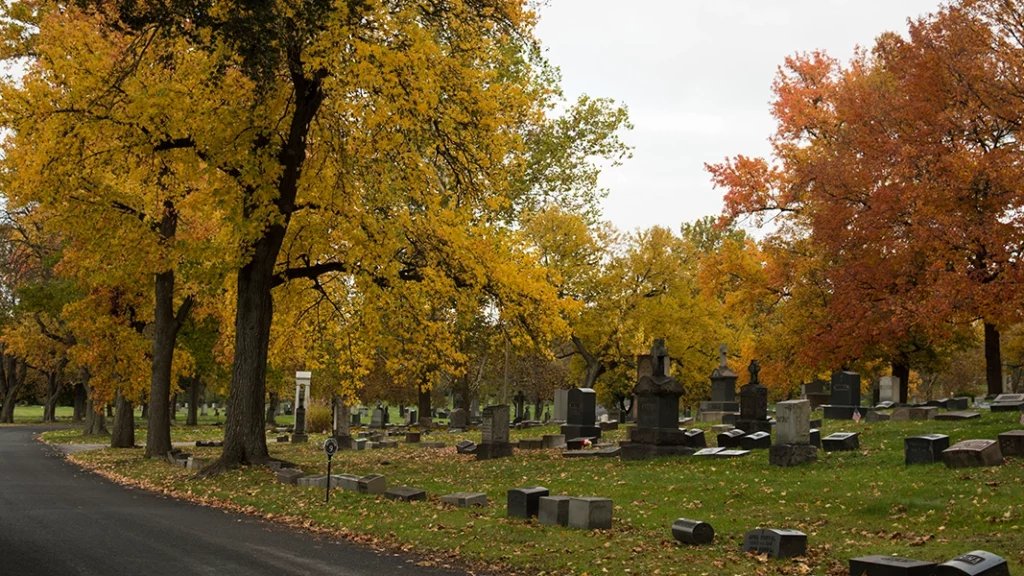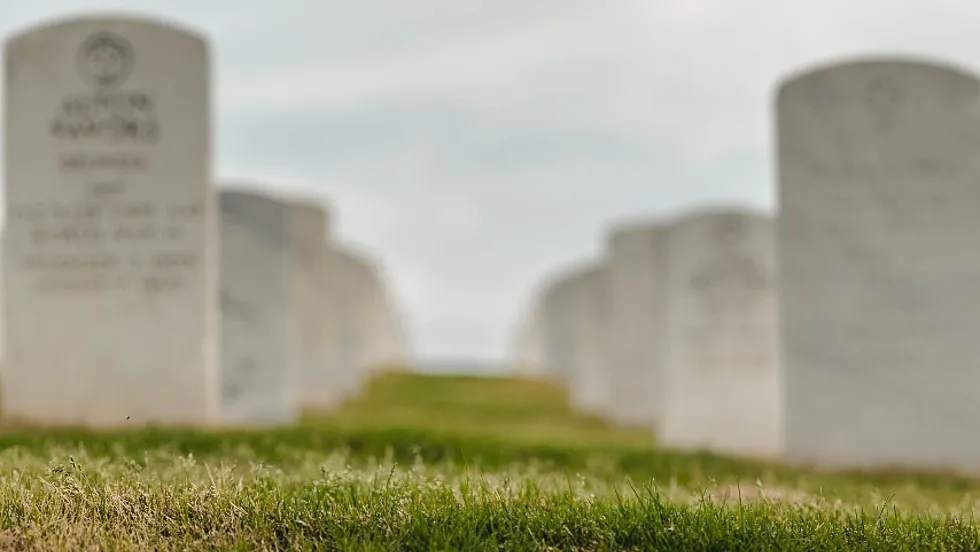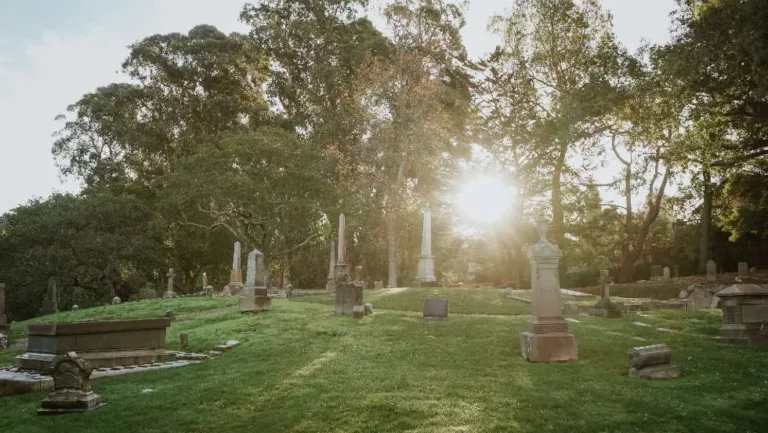It typically takes about 6 to 12 months for a grave to settle properly.
Grave settling, a natural and inevitable process, refers to the gradual subsidence or compacting of the earth around a burial site following the interment of a deceased individual.
The significance of grave settling within cemeteries cannot be overstated. This natural process plays a vital role for several reasons:
- Maintenance: Grave settling necessitates ongoing care and maintenance of burial sites, ensuring that they remain dignified, safe, and accessible.
- Planning: Understanding the timeline of grave settling is essential for cemetery management to plan for future burials, maintain the cemetery’s aesthetics, and allocate space efficiently.
- Symbolism: Grave settling symbolizes the earthly return of the departed, emphasizing the cyclical nature of life and death. It is a testament to the integration of the individual into the natural world.
- Regulation: In many cases, laws and regulations govern the maintenance and inspection of graves to uphold standards related to safety and appearance.
What Is Grave Settling?

Definition and Causes Grave Settling.
It’s the gradual subsidence or sinking of the ground in and around a burial plot following an interment. This natural phenomenon is primarily caused by several factors:
Soil Compression: The weight of the soil, casket, and any concrete vault or burial liner used can compress the soil beneath, causing it to settle.
Decomposition: As the body decomposes within the casket, the space it once occupied decreases, leading to further settling.
Environmental Factors: Temperature, moisture levels, and soil composition changes can also contribute to grave settling over time.
B. Importance of Understanding Grave Settling Recognizing and comprehending the process of grave settling is crucial for various reasons:
Maintenance: Cemetery caretakers must monitor and address settling to ensure that grave markers, headstones, and memorials remain level and intact. This maintenance preserves the dignity and respect associated with burial sites.
Land Use Planning: Cemetery administrators can better plan for land use and future burials by understanding how much space may be needed to accommodate settling graves and prevent overcrowding.
Cultural and Symbolic Significance: Grave settling is a part of the natural cycle of life and death, signifying the deceased’s return to the earth. Understanding this process can provide solace and comfort to grieving families.
Legal and Regulatory Compliance: Some regulations and laws may require periodic inspections and maintenance of graves to ensure they conform to standards related to safety and aesthetics.
Factors Affecting Settling Time of Grave
- Influential Factors in Grave Settling
The duration it takes for a grave to settle can vary significantly due to several factors, including:
Soil Type: The type of soil in the cemetery plays a significant role. Sandy soils tend to settle more quickly than clayey soils because they are less compact and allow for easier displacement of soil particles.
Weather Conditions: Weather patterns and changes in temperature and moisture levels can affect settling. Extreme weather, such as heavy rainfall or prolonged drought, can expedite or slow down the process.
Burial Depth: Graves that are dug deeper may take longer to settle because there is more soil to compact and displace. Shallower graves may settle more rapidly.
Casket Type: The type of casket used can also influence settling. A heavy, durable casket may compress the soil more than a lightweight one.
Vault or Liner: If a concrete vault or burial liner is used, it can impact settling time. These structures can slow down settling as they distribute the weight more evenly.
B. Role of Soil Type, Weather, and Burial Depth
Soil Type: Sandy soils, with their loose and well-draining characteristics, tend to settle more quickly. In contrast, clayey soils are denser and compact more slowly, resulting in longer settling times.
Weather Conditions: Rainfall can increase settling by compacting the soil, whereas prolonged dry spells may delay the process. Freezing temperatures can also affect settling, as the expansion and contraction of frozen soil can lead to uneven settling.
Burial Depth: Deeper graves generally take longer to settle due to the larger volume of soil that needs to be compacted and displaced. Shallower graves may settle more rapidly as there is less soil involved.
The Role of Burial Materials of Grave to Settle
Impact of Coffin or Casket Choice
The choice of coffin or casket can indeed influence the process of grave settling:
Casket Weight: Heavier caskets, typically made of materials like metal or hardwood, can expedite settling. The added weight increases the compression of the soil beneath, causing it to compact more quickly.
Biodegradable Caskets: On the other hand, biodegradable caskets, made of materials like wicker or cardboard, may slow down the settling process.
These materials decompose more readily, leaving voids in the soil as they break down. These voids can take longer to settle, potentially resulting in a prolonged settling period.
Impact of Concrete Burial Vaults
Concrete burial vaults are often used to encase the casket before burial. Their use can have the following impacts on grave settling:
Slower Settling: Concrete burial vaults are designed to be durable and protective, providing additional support for the casket.
This added structural integrity can slow down the settling process, as the vault distributes the weight more evenly, preventing rapid compaction of the soil below.
Preservation: While concrete vaults may extend the settling timeline, they also help preserve and protect the casket from the elements, minimizing the risk of damage or decomposition.
This can be important for families seeking long-term preservation of their loved one’s remains.
Environmental Factors Affecting the Grave Settling
Influence of Environmental Conditions on Settling
Environmental conditions, such as rainfall and temperature, can significantly influence the process of grave settling:
Rainfall: Rainfall can have a notable impact on settling. Excessive rainfall can lead to soil compaction as the water saturates the ground, making it denser. This can expedite settling, especially in areas with frequent and heavy rainfall.
Temperature fluctuations, particularly freeze-thaw cycles in colder climates, can also affect settling. When water in the soil freezes and then thaws, it can create voids and uneven settling, potentially prolonging the process.
B. The Climates of a region can differentiate the grave settling from other regions.
Humid and Rainy Climates: Cemeteries in regions with high humidity and frequent rainfall may experience quicker settling due to the moist soil conditions. The combination of moisture and compaction can lead to more rapid settling.
Dry and Arid Climates: Grave settling may occur more slowly in arid regions with minimal rainfall. The lack of moisture can hinder soil compaction, potentially extending the timeline for settling.
Cold Climates: Cemeteries in cold climates may encounter challenges associated with freeze-thaw cycles. These cycles can disrupt settling by creating pockets of uneven compaction, resulting in a more extended and erratic settling timeline.
Temperate Climates: Regions with moderate temperatures and consistent moisture levels may experience settling that falls within the typical 6 to 12-month timeframe. These conditions are less likely to have extreme impacts on the process.
Maintaining Grave Sites
Cemetery and Family Involvement in Maintenance
Maintaining grave sites during the settling process is a collaborative effort between cemeteries and families to ensure the deceased’s dignity. Here’s how both parties can contribute:
Cemetery Caretakers: Cemeteries have a responsibility to monitor and maintain grave sites. They can:
- Regularly inspect graves to assess settling progress and identify any issues.
- Re-level and reposition grave markers, headstones, and memorials as needed to keep them upright and visible.
- Address any sunken or uneven areas by adding soil or turf to maintain a neat and well-kept appearance.
Families: Families can also play a role in maintaining the appearance of the grave site:
- Respect cemetery rules and regulations to ensure personal mementos and decorations do not impede maintenance efforts.
- If they notice issues with the grave site or markers, communicate with cemetery staff.
- Participate in regular visits to the grave site to ensure that it remains a place of remembrance and respect.
B. Importance of Leveling and Adding Soil Leveling and adding soil as needed are crucial aspects of grave site maintenance for several reasons:
Respect and Dignity: Maintaining a level and well-kept grave site is a sign of respect for the deceased and their memory. It ensures that the final resting place remains visually and emotionally meaningful to family members and visitors.
Safety: Uneven or sunken grave sites can pose safety hazards to cemetery visitors. Leveling the ground and addressing settling issues help mitigate these risks.
Preservation: Grave markers, headstones, and memorials are essential for preserving the memory of the deceased. Ensuring they remain upright and in good condition preserves the historical and cultural significance of the site.
Cemetery Aesthetics: Maintaining the overall appearance of the cemetery reflects positively on the institution and creates a respectful environment for all visitors.
The Significance of Markers
Temporary Markers During the Settling Process During the initial settling period, temporary markers play a crucial role in identifying and honoring the deceased. Here’s why they are important:
- Identification: Temporary markers serve as a means of identifying the grave’s location before permanent markers are installed. This is especially important for cemetery staff, family members, and visitors.
- Respect: They show respect for the deceased by ensuring that the grave is appropriately marked and acknowledged, even as the settling process continues.
- Navigational Aid: Temporary markers help visitors find the correct burial site, providing a sense of closure and connection to the departed loved one.
- Ceremonial Purpose: Families often hold memorial services and gatherings shortly after a burial. Temporary markers allow these ceremonies to take place with a clear focal point.
Timing for Permanent Grave Markers Permanent grave markers are typically installed once the settling process has sufficiently stabilized the ground. The timing can vary but generally follows these guidelines:
- 6-12 Months: In most cases, permanent markers are installed approximately 6 to 12 months after the burial. This timeframe allows for significant settling to occur, reducing the risk of markers becoming uneven or displaced due to ground movement.
- Cemetery Policies: The specific policies and procedures regarding marker installation may vary between cemeteries. Some cemeteries may have guidelines that dictate when permanent markers can be placed.
- Family’s Decision: In some instances, the timing of permanent marker installation may be at the discretion of the deceased’s family. They may choose to install it sooner or later based on their preferences and the state of the grave.
Realistic Expectations for Grave Settling

Realistic Expectations for Grave Settling Time Frames It’s important for families to have realistic expectations regarding the timeframes for grave settling. Here’s some guidance:
Typical Timeframe: Families should understand that the typical settling time frame for graves is approximately 6 to 12 months.
Individual Variation: Every burial site is unique, and settling times can differ. Some graves may settle more quickly, while others may take longer. Factors like soil composition and environmental conditions can influence this.
Maintenance During Settling: Families should also be aware that temporary markers will be in place during the settling period. These markers serve to identify the grave until permanent markers can be safely installed.
Patience and Understanding: Encourage families to exercise patience and understanding during this period.
The settling process is a natural occurrence, and it’s essential to allow the ground to stabilize properly to ensure the long-term integrity of the grave site.
Guidance on Replacing Temporary with Permanent Markers The transition from temporary to permanent markers should be well-timed to ensure that the ground is stable.
Here’s some guidance on when to consider replacing temporary markers:
Consult the Cemetery: Families should communicate with the cemetery administration to determine when replacing temporary markers with permanent ones is appropriate.
Cemetery staff can provide guidance based on the specific conditions of the grave site.
Wait for Stability: It’s generally advisable to wait until the settling process is complete or nearing completion. As mentioned earlier, this is typically around 6 to 12 months after the burial.
Waiting ensures that the permanent marker will be installed on stable ground.
Personal Considerations: Families may also consider personal factors, such as the significance of certain dates or anniversaries when deciding on the timing of the marker replacement. However, balancing personal preferences with the need for ground stability is essential.
FAQs
Is it normal for graves to settle over time?
Yes, it is normal for graves to settle to some extent after a burial.
How long does it take for a grave to settle completely?
The time for a grave to settle completely can vary, but it may take several months to a few years.
Does the type of soil affect settle time?
Yes, the type of soil in the burial site can influence how quickly a grave settles. Loose soil settles faster than denser soil.
Can weather conditions impact settling?
Yes, weather conditions, such as rainfall and temperature fluctuations, can affect the rate at which a grave settles.
Do deeper graves take longer to settle?
Yes, deeper graves may take longer to settle due to the greater amount of soil above.
Does the type of coffin or casket matter?
Yes, the type of coffin or casket used can influence how a grave settles. Wooden coffins may decompose faster than metal caskets.
Can the size of the grave affect settling time?
Yes, larger graves or graves with multiple burials may take longer to settle than single, smaller graves.
Can the burial site’s maintenance impact be settled?
Yes, regular maintenance of the burial site, such as filling in depressions and adding soil, can affect how quickly a grave settles.
Is it necessary to place a temporary marker on a grave initially?
Yes, it is common to initially place a temporary marker on a grave to allow for settling before installing a permanent marker.
Do cemeteries monitor and manage the settling process?
Yes, cemeteries typically have protocols for monitoring and maintaining grave sites, including leveling and reseeding as needed.
Can families replace temporary markers with permanent ones once settling is complete?
Yes, families often replace temporary markers with permanent markers once they are satisfied with the level of settling at the grave site.
Conclusion
Grave settling is a natural and essential part of the burial cycle, symbolizing the deceased’s return to the earth. It is a process that unfolds over time, typically 6 to 12 months, and is influenced by various factors. Throughout this journey, patience and understanding are key.
Remember that temporary markers serve as meaningful placeholders until the ground is stable enough for permanent markers.
As you look for the settling process, it’s important to recognize that the final resting place is a tribute to a life lived, and it deserves the care, respect, and love that you continue to offer in remembrance.

